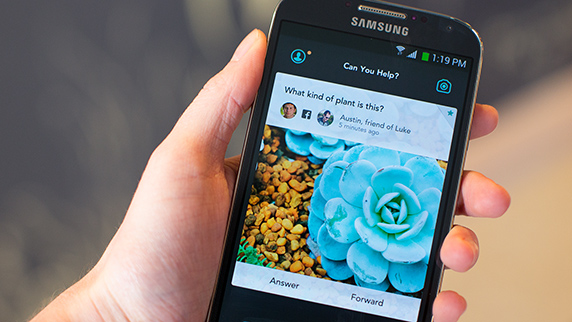Jelly, a new question-and-answer platform from Twitter co-founder Biz Stone, is coming out of stealth today. The app, available on both iOS and Android worldwide, will go head-to-head with the likes of Quora and ChaCha but also go a step further, incorporating features like visual imagery to steer people to getting better answers from within and outside their social networks.
Stone has announced the new app on the Jelly blog, and also in an email that he has sent out to some people today. Here’s what he’s noted in the email:
Jelly is available on both iOS and Android worldwide. We’ll be announcing today with a blog post at http://jelly.co [the link is now live] including links to download the app for free [these are not]. Jelly is a new way to search with pictures and people from your social networks. It’s also people helping each other—something that’s both meaningful and fun.– Jelly works with your existing social networks. In addition to asking, you may find yourself answering questions as well.– Questions can be forwarded outside the app so your friends who don’t have Jelly can still help. It feels good to help!– Ask questions with images to deepen the context. Crop, reframe, zoom, and draw on your images to get more specific.
Jelly will not be the first service to tap into the “hive mind” for answers — sites like Yahoo Answers and Ask.com have been doing this for years now, and services like Quora (and with less success Facebook) have taken up the baton by incorporating the idea of targeting questions and answers to social networks, both to provide responses, and to act as an interested audience of readers for those responses. Latterly, Twitter is used in this way, too, although less formally.
What Jelly will be doing differently is that it will tap into new algorithms to help target the questions to specific networks, specifically using images. There are two things to note here:
The first is the idea of using images to ask questions.
The rise of image-based social networks like Pinterest and Instagram point to the rising popularity of using images as the primary form of communication — or at least the launching point — for a conversation on a social network. It stands to reason that we will see ever more intelligent algorithms created to help parse the long tail of content on those networks. (As a case in point, just yesterday Pinterest announced the acquisition of visual search startup VisualGraph.) Jelly is tapping into that idea, too: today the images are there to cue responses from users, but my bet is on the company looking for ways of automatically parsing those images and then using that data to help direct the questions better to people who might be well-placed to answer (or to even provide the answers directly).
The other thing about using images is that it points to the platform of the moment: mobile. Gartner’s forecasts about device shipments in the year ahead indicate that PC sales are continuing their decline, while those of mobile devices like phones and tablets continue to rise. The fact is that it’s fun and easy to take a picture using a mobile device — and it is slightly more onerous to type something. Jelly putting visual cues at the heart of its platform plays into this and positions it as a Q&A platform for tomorrow.
And the last thing about images is that it points to an interesting way that the service can potentially scale. While English is the lingua franca of the Internet, images truly do transcend language barriers.
The second is the amorphous idea of the jellyfish itself as a conceptual idea of how to source information.
While a group of followers on a social network like Twitter feels like a set idea, here the idea is that the network can change shape (like a jellyfish) depending on the circumstances.
“We chose the jellyfish to represent our product because it has a loose network of nerves that act as a ‘brain’ similar to the way we envision loosely distributed networks of people coordinating via Jelly to help each other,” Stone notes. It’s not the first time Stone’s q&a interested have been piqued by the amorphous imagery of a jellyfish.
